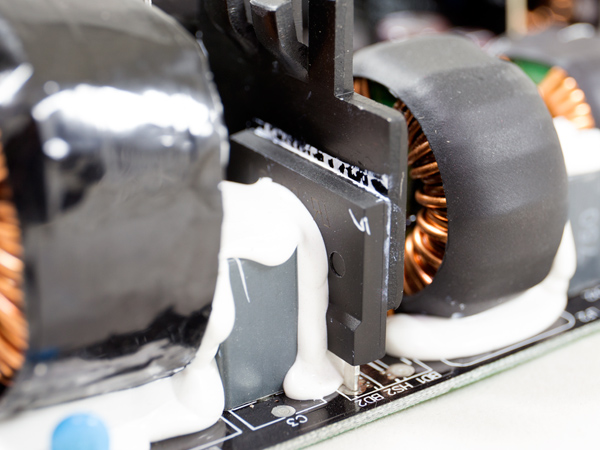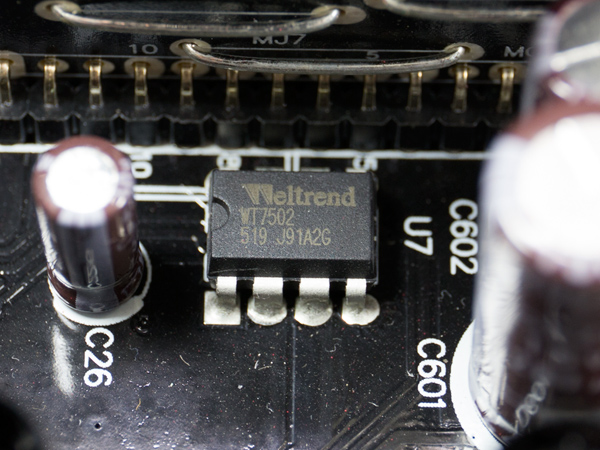Corsair RM750x PSU Review
Corsair released its RMx PSU line, which the company claims will offer good performance along with silent operation. Unlike the RMi models, the RMx units lack a digital interface, a fan test button, and uses a Rifle bearing fan instead of an FDB version.
Why you can trust Tom's Hardware
A Look Inside And Component Analysis
Parts Description
Before proceeding with this page, we strongly encourage you to a look at this article, which will provide you with valuable information about PSUs and their operation, allowing you to better understand the information given below. Our main tools for disassembling PSUs are a Thermaltronics soldering and rework station and a Hakko 808 desoldering gun.
| Primary Side | |
|---|---|
| Transient Filter | 6x Y caps, 2x X caps, 2x CM chokes, 1x MOV |
| Inrush Protection | NTC Thermistor |
| Bridge Rectifier(s) | 1x GBJ25L06 (600V, 25A @ 113°C) |
| APFC MOSFETS | 2x Vishay SiHF22N60E (650V, 13A @ 100°C, 0.18 Ohm ) |
| APFC Boost Diode | 1x Vishay 8S2TH061 (600V, 8A @ 120°C) |
| Hold-up Cap(s) | 2x Nippon Chemi-Con (400V, 390uF & 470uF or 860uF combined, 2000h @ 105°C, KMR) |
| Main Switchers | 2x Vishay SiHG20N50C (560V, 11A @ 100°C, 0.27 Ohm ) |
| APFC Controller | Infineon ICE3PCS01G - CM03X |
| Switching Controller | Infineon ICE2HS01G |
| Topology | Primary side: Half-Bridge & LLC Resonant ConverterSecondary side: Synchronous Rectification & DC-DC converters |
| Secondary Side | |
| +12V MOSFETS | 6x Sinopower SM4021NAKP (40V, 100A @ 100°C, 2.7 mOhm ) @ VGS=6V) |
| 5V & 3.3V | DC-DC Converters: 4x M3006D & 2x M3004D fets PWM Controller: APW7159 |
| Filtering Capacitors | Electrolytics: Chemi-Con (105°C, KZE & KZH series) Polymers: Nippon Chemi-Con |
| Supervisor IC | Weltrend WT7502 & Weltrend WT7518 |
| Fan Model | NR135L (12 V, 0.22 A, Rifle Bearing) |
| 5VSB Circuit | |
| Rectifier | PFR20V45CT (45V, 20A, VF: 0.42V max @ 125°C) |



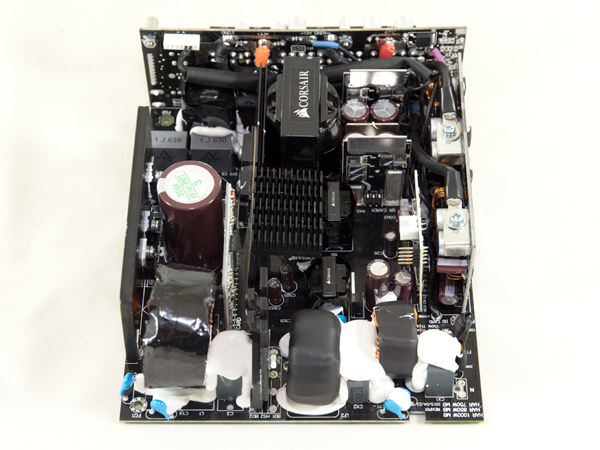

Basically, this is exactly the same platform as the RM750i. The only exception is the absence of the digital interface, which allows the monitor to partially control the PSU through the Corsair Link software. In both cases (the RM750i and RM750x), analog circuits control the PSU's operation in the APFC converter and the primary/secondary sides, meaning that the digital interface acts only as a bridge between the PSU and the system. Hence, it has nothing to offer, performance wise.
All RMi and RMx units are manufactured by CWT, Corsair's favorite OEM. In the primary side we meet a half-bridge topology along with an LLC resonant converter. In the secondary side a synchronous design is used, as usual, along with a couple of DC-DC converters for the rectification of the minor rails. The use of only Japanese capacitors promises increased reliability and offers a stable performance over time. Finally, as CWT used to do, this platform doesn't use any proper heat sinks in the secondary side. This doesn't seem to affect this unit's reliability; however, if it did, the company wouldn't offer such a lengthy warranty.



The AC receptacle hosts two Y caps. The other parts of the EMI filter are located on the main PCB, including four Y and two X caps, two CM chokes and a small MOV.
The single GBJ25L06 bridge rectifier is bolted on a dedicated heat sink. It can handle up to 25A of current, easily meeting the demands of this PSU.



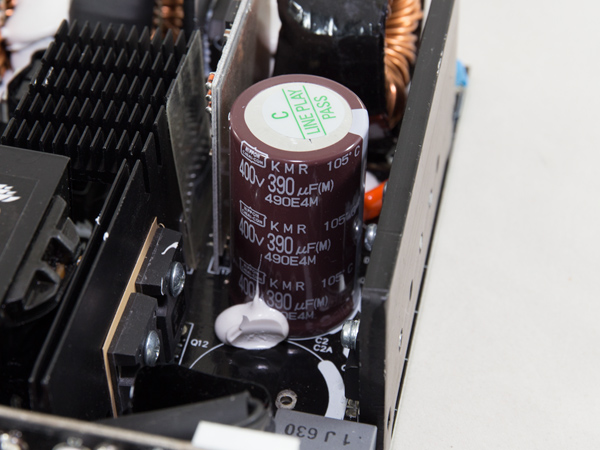
Two Vishay SiHG22N60E FETs are used along with a single Vishay 8S2TH061 boost diode by the APFC converter. The pair of bulk caps is provided by Chemi-Con (400V, 390uF & 470uF or 860uF combined, 2000h @ 105 Celsius, KMR) and their combined capacity is more than enough for this specific platform.


The APFC controller is hosted on a vertical daughterboard. The APFC controller is an Infineon ICE3PCS01G that is backed up by a CM03X Green PFC controller. On the same board we also found the LLC resonant controller, an Infineon ICE2HS01G.
Get Tom's Hardware's best news and in-depth reviews, straight to your inbox.
Arranged into a half-bridge topology, two Vishay SiHG20N50C FETs are used as main switchers.




As we already stated, the secondary-side CWT didn't use any proper heat sinks, even though this PSU features a semipassive mode. To minimize noise output, the fan isn't spinning at all when the PSU is in this mode. The FETs that regulate the +12V rail — four Sinopower SM4021NAKP — are installed on two vertical PCBs. In addition to their power-transfer duties, a small number of bus bars also work to cool the PCBs. Four Chemi-Con electrolytic caps (rated at 105 C) are installed between the PCBs that hold the +12V FETs. These caps are used for ripple-filtering purposes.


A large daughterboard houses the couple of DC-DC converters that generate the minor rails. The common PWM controller is an Anpec APW7159, and each VRM uses a couple of M3006D FETs, along with a single M3004D FET.
Housekeeping is done by a Weltrend WT7502 IC, which is installed on the main PCB.
A PFR20V45CT Schottky barrier diode (SBR) regulates the 5VSB rail.
The MCU PCB in the RM750x looks empty, since the PIC32MX that is used on the same card in the RM750i is missing. In addition, instead of a four-pin fan header, a two-pin fan header is used in this case because the PWM doesn't control it.

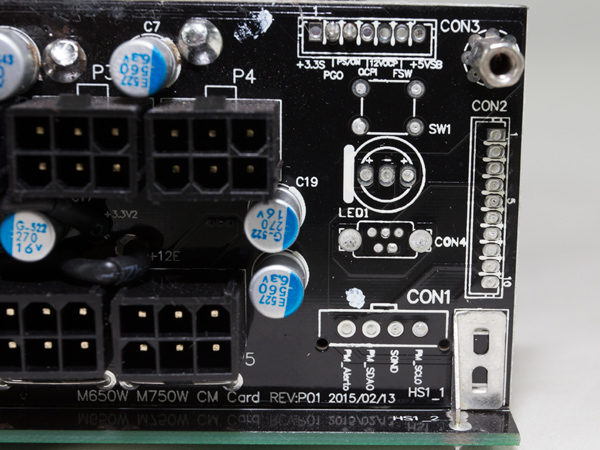
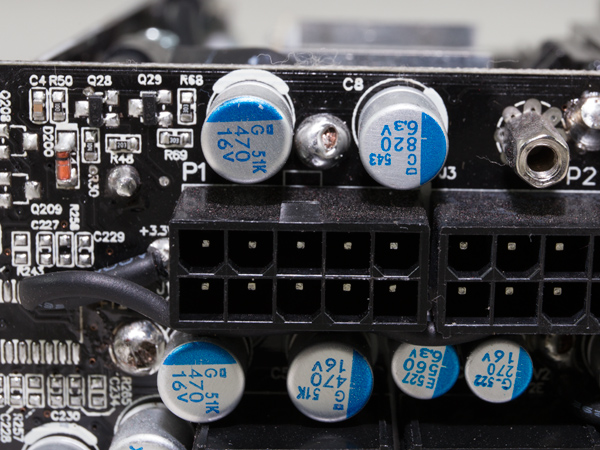


At the front side of the modular PCB, quite a large number of Chemi-Con polymer caps filter the rails. At the rear side of the same board, several thick cables transfer power from the regulators to the modular sockets.

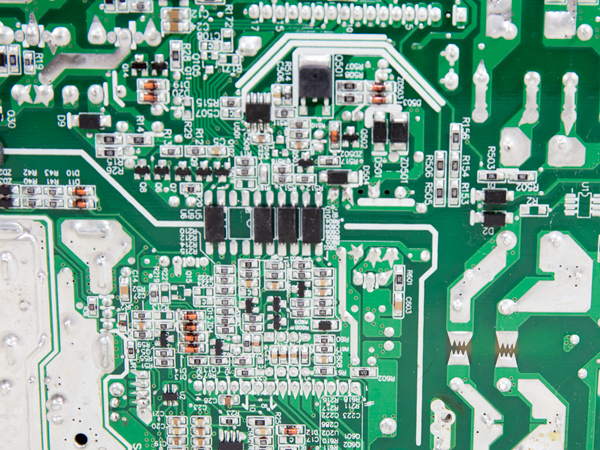

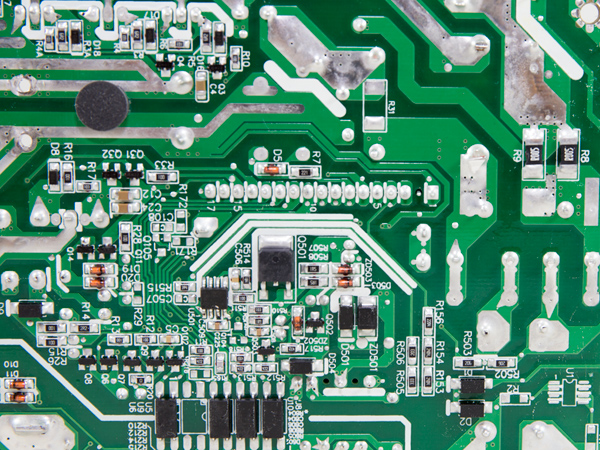







Soldering quality is good overall, and we didn't spot any long component leads, which we hate to see, since they can cause trouble.
To reduce production costs, Corsair used a rifle-bearing fan instead of an FDB fan. The NR135L fan (135mm, 12V, 0.22A) is a low-speed unit with very low noise output even at higher speeds. The semipassive mode and the highly relaxed fan profile combine to help this fan offer a very silent operation for the RM750x, under all conditions.
Current page: A Look Inside And Component Analysis
Prev Page Packaging, Contents, Exterior And Cabling Next Page Load Regulation, Hold-Up Time And Inrush Current
Aris Mpitziopoulos is a contributing editor at Tom's Hardware, covering PSUs.
-
Blueberries I've been promoting these for a while, it's nice to see Tom's do an article on them. The only reason these are Gold rated is because they just miss the Platinum rating at 20%.Reply
They have a 650x as well that's a little cheaper. -
Amdlova High Rate Faliure can be the the name of this series of corsair. for Now EVGA or SEASONIC power supplies. don't spend a penny on corsair products...Reply -
Aris_Mp Please keep in mind that some Corsair PSUs are also made by Seasonic. Also this series is very new to have a high rate of failures. Unless you have some solid facts to share on the older RM line which is out for quite some time now.Reply -
jonnyguru Reply16801974 said:High Rate Faliure can be the the name of this series of corsair. for Now EVGA or SEASONIC power supplies. don't spend a penny on corsair products...
Wrong on so many levels.
YOU do not have the failure rate for this or any other Corsair PSU.
This PSU is the RMx, not the RM, so even if you did have a failure rate, it would only be about two weeks of data.
If you were talking about the RM and not the RMx, and you actually had failure rate data, you would see that the failure rate on the RM wasn't really high at all.
-
PureBlackFire ReplyHigh Rate Faliure can be the the name of this series of corsair. for Now EVGA or SEASONIC power supplies. don't spend a penny on corsair products...
*sigh* nonsense comment of the day.
-
chalabam Tomshardware:Reply
I don't know if this is a problem of your site, or my PC/IP, but frequently the charts do not load, even when the page "ends" loading.
Sometimes, if I "reload", then the charts also load.
I open all the article pages simultaneously, on different tabs, so I don't need to wait for each one to load. -
Rookie_MIB The older RM units weren't 'bad' really, they were ok, but Corsair has been stepping up its game with quality parts and build on some of these newer units which is nice to see. You can never have too many solidly designed units to choose from - competition toughens the breed.Reply -
Blueberries ReplyHigh Rate Faliure can be the the name of this series of corsair. for Now EVGA or SEASONIC power supplies. don't spend a penny on corsair products...
Did you even LOOK at the article? The only problem with these are the Sinopowers on the secondary side, and that's not even a "bad" thing. Oh and btw, some of the best power supplies in the world are Superflower OEMs produced by Corsair. -
mavikt With these in depth coverage of PSU's I propose introducing a tier'ing table thing at the and of each review (or perhaps a best buy PSU of the month) equivalent to what's done for CPU's and GPU's, ranking PSU models (perhaps too the makers). I saw a comment here on toms on another PSU news flash in the comment section referring to such thing in the forum but now I can't find it.Reply
Permanent'ing such thing from the editorial side would be great! -
Reply
High Rate Faliure can be the the name of this series of corsair. for Now EVGA or SEASONIC power supplies. don't spend a penny on corsair products...
Did you even LOOK at the article? The only problem with these are the Sinopowers on the secondary side, and that's not even a "bad" thing. Oh and btw, some of the best power supplies in the world are Superflower OEMs produced by Corsair.
Corsair doesn't use SuperFlower anywhere in its lineup. CWT, Great Wall, Flextronics, Seasonic and Chicony which has since been dropped are all the OEMs Corsair uses or has used.
